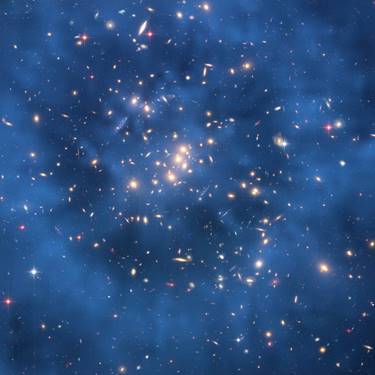Windows of Astronomy |
|
Dark matter How can dark matter be a window on the universe? Surely it is invisible and it has never been detected after decades of trying in ‘laboratories’? Is it not like trying to draw a picture of coal in a coal cellar without any light? Well yes, but a bat could make a good go at finding the distribution of coal in a coal cellar at the dead of night, for it uses another means, not light. So it is with dark matter. We need to ‘observe’ with a means other than electromagnetic radiation. Dark matter is not coal or any other dark object we can think of. Dark matter is mapped only through its gravitational influence. Our galaxy, the Milky Way, is deduced to be surrounded by a near spherical halo of dark matter. Images of dark matter are necessarily the result of a computational deduction of how much dark matter must be present to create the observed gravitational effect. The presence and distribution of distant dark matter can be deduced from its gravitational lensing effect on very distant galaxies. The total amount of dark matter present in galaxy clusters can also be deduced to agree within reasonable limits with the amount expected. Cosmology predicts that dark matter should amount to more than five times the amount of ‘star stuff’, the stuff of the periodic table. It is, of course, immensely frustrating that we can’t detect it directly or have a clear idea of how it fits into all we know about elementary particles. In this sense, dark matter remains one of the great mysteries of the universe. Some astronomers even deny it exists but not only can its distribution be mapped in favourable circumstances but computer models of galaxy evolution don’t work convincingly without dark matter included. Dark matter fits in with a range of different phenomena to the extent that I would be surprised if it were found to be a mistaken concept. It is part of our current understanding of the universe.
|
A cluster of galaxies (CL0024+17) seen by the Hubble space telescope showing multiple images of galaxies caused by an unseen ring of dark matter about 5 million light years across that has been superimposed in diffuse blue. Courtesy NASA |



